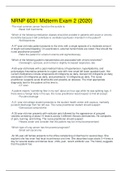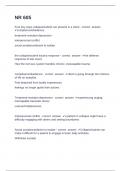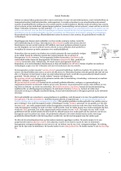Abramowitz et al. (2019)...................................................................................................................2
Mineka & Zinbarg (2006)...................................................................................................................5
Clark (1999)......................................................................................................................................11
Week 2: Specific phobias.....................................................................................................14
Davey (1997)....................................................................................................................................14
Choy et al. 2007...............................................................................................................................16
Craske et al. (2004)..........................................................................................................................21
Week 3: OCD....................................................................................................................... 25
Van den Hout (2012)........................................................................................................................26
Ferrando & Selai (2021)...................................................................................................................28
Rachman (2002)...............................................................................................................................30
Week 4: PTSD...................................................................................................................... 32
Mclean et al, (2022).........................................................................................................................32
Hyland et al. (2021)..........................................................................................................................34
Brewin & Holmes (2003)..................................................................................................................35
Week 5: GAD....................................................................................................................... 40
Van der Heiden et al. (2011)............................................................................................................40
Sadeghi et al. (2015)........................................................................................................................44
Cuijpers et al. (2014)........................................................................................................................44
Week 6: Panic disorder........................................................................................................ 45
Salobskis & Clark (1990)...................................................................................................................45
Deacon et al. (2013).........................................................................................................................46
Meyerbröker & Powers (2015)........................................................................................................48
Week 7: Social Anxiety Disorder..........................................................................................51
Morrison & Heimberg (2013)...........................................................................................................52
Leigh & Clark (2018).........................................................................................................................55
Schultz & Heumberg (2008).............................................................................................................59
Week 8: Transdiagnostic approach......................................................................................63
Wibbelink et al. (2023).....................................................................................................................63
Fried et al. (2017).............................................................................................................................64
Olatunji, Cisler, Tolin (2010).............................................................................................................67
Week 1: Emotion Theory
, 2
● Abramowitz et al. (2019)
● Mineka & Zinbarg (2006)
● Clark (1999)
Abramowitz et al. (2019)
Exposure therapy refers to the process of helping a patient approach and engage with anxiety-
provoking stimuli that objectively pose no more than everyday risk without the use of anxiety-
reduction “coping” skills.
● Anxiety-evoking stimuli can be alive (e.g., snakes, clowns), inanimate (e.g., balloons, toilets),
situational (e.g., funeral homes, bridges), cognitive (e.g., ideas of committing heinous acts,
memories of a traumatic event), or physiological (e.g., racing heart, dizziness).
Engagement with the objectively safe (or “low-risk”) fear eliciting stimulus typically precipitates a
response ranging from mild apprehension to intense panic, the basis for which is the patient’s
exaggerated expectation of danger.
➔ Mechanism of exposure: if a person is exposed to a stimulus without the expected,
frightening consequence, the anxiety will decrease.
Definition anxiety: an organism’s response to the perception of threat. This implies that actual
threat need not be present in order to experience anxiety.
● Normal anxiety: different brain regions (visual thalamus, visual cortex, amygdala). The brain
stimulates the release of adrenaline from the adrenal glands, which activates the
sympathetic nervous system and initiates the body’s “fight-or- flight response.”
1. Psychological level: body prepares for physical exertion (heartrate arises).
2. Cognitive level: shift in attention towards the perceived threat.
3. Behavioral level: individual is compelled to take actions that are geared toward
fighting, avoiding, or escaping the feared stimulus.
Critical for surviving ‘’in times of danger, anxiety can be a person’s best friend’’.
● Abnormal anxiety: anxiety occurs in the absence of danger or when it is out of proportion
relative to the actual threat.
→ Often a vicious cycle in which the perception of threat leads to anxious responding, which
leads to more threat perception, and so on.
→ And avoiding these fear cues. The fear to persist as the person is unable to correct their
fear. And this can worsen the anxiety itself.
1) Passive avoidance: not raising your hand in class.
2) Active avoidance: used when the stimuli cannot be avoided. Seeking control in a
different way, for example by compulsive washing.
DSM-5 Diagnoses characterized by anxiety
Disadvantages:
● To begin with, the categorical delineation of the DSM system cannot fully capture the
breadth and depth of human emotional experience.
● The DSM also makes an arbitrary distinction regarding the level of severity that constitutes
an anxiety (or anxiety- related) disorder. However, as can be seen from the discussion of
normal and abnormal anxiety, fears and worries are more like blood pressure; everyone has
it, but having too high (as well as too low) levels can be problematic.
, 3
● A categorically based diagnostic system does not provide treatment recommendations for
individuals whose symptoms do not fall into a specific category or who have subthreshold
symptoms.
Solution?
New view of mental disorder: “dyscontrolled organismic impairment in psychological functioning” →
A specific mechanism is not functioning optimally.
We approach exposure therapy as targeting key processes underlying the persistence of clinical
anxiety rather than a treatment for a specific “disorder”.
● The same basic principles of exposure therapy can be applied to any patient’s anxiety
problem, regardless of which DSM diagnostic category best describes it. → transdiagnostic
approach
Etiology versus maintenance
Exposure therapy focuses on the psychological processes that maintain the problem, rather than
those that might lead to its development or etiology (you can’t change the past). You can learn to
replace maladaptive patterns.
The following elements are necessary for successful treatment of clinical fear and anxiety:
1. Patients must be presented with information that is incompatible with their maladaptive
beliefs about the dangerousness or intolerability of feared stimuli
2. Behaviors that interfere with the acquisition and consolidation of this new information must
be eliminated
3. This new information must be strengthened in memory and generalized as broadly as
possible so that it is recalled in diverse contexts and over time.
Assessment and treatment planning
Exposure therapy begins with a thorough assessment of the patient’s problem with anxiety:
1. The contexts in which anxiety is triggered
2. The anticipated feared consequences of encountering fear triggers
3. The strategies used to seek safety from harm and reduce anxiety by avoiding and escaping
from these triggers.
The therapist next thoroughly explains the exposure procedures and why they are expected to be
helpful (clear rationale, understandable and also information about the provocation and distress).
Practicing exposure
In any case, the aim of a particular exposure is to engage the patient with the fear stimulus in a
systematic way and without the use of safety- seeking or anxiety- reducing coping strategies so that
the patient can learn that the feared outcome is not as likely or as severe as was predicted and that
feelings of anxiety are safe and manageable regardless of their intensity or duration. → It can also be
exposure to certain thoughts
● Learning is focused on whether the expected negative outcome occurred, how manageable
it was if it did occur, and the degree to which the patient’s distress was tolerable.
(sometimes multiple times are necessary)
When the exposure practice is over, patients are helped to further consolidate the newly gained
information by discussing what they learned during the experience. Patients are also helped to
, 4
recognize that regardless of how anxious they felt, and how long those feelings persisted, they were
able to get through the experience.
A history of exposure therapy
● One of the first forms of exposure to emerge in the era of behavior therapy was systematic
desensitization (SD): SD involves weakening the association between anxiety and an
objectively nondangerous phobic stimulus by pairing the phobic stimulus with a
physiological state that is incompatible with anxiety. The goal of SD is for the patient to be
completely relaxed while in the presence of his or her phobic stimuli. Later also imagines
exposure.
→ Theoretical basis of SD : reciprocal inhibition (i.e., anxiety inhibits feeding and feeding
inhibits anxiety)
● Flooding therapy: Flooding refers to a nongraduated approach in which the patient rapidly
confronts his or her most feared stimuli, either in imagination or in real life, while minimizing
escape from the fear- provoking context (i.e., response prevention). The assumption is that
flooding results in the activation of anxiety, which then subsides over time in the absence of
avoidance patterns and results in the extinction of the fear.
● Implosive therapy: Implosive therapy was considered a variation of flooding, with the
following differences. First, all presentations of fear- evoking situations were done in
imagination. Second, the imagined scenes were often exaggerated or impossible situations
designed to provoke as much anxiety as possible. And it contains psychodynamic elements
(i.e. sources: rejection, sex etc.)
→ Theoretical basis of Flooding and implosive therapy: extinction: in which the repetition of
the feared stimulus in the absence of the feared consequence and any escape or avoidance
behaviors will result in the reduction of the fear.
→ It all involved exposure to fear- provoking stimuli and abstinence from fear- reducing escape and
avoidance responses > led to gradual exposure therapy that is devoid of the relaxation component
of SD and the psychodynamic element of implosive therapy.
Cognitive-Behavioral Therapy
● CBT to address anxiety disorders: The multicomponent manuals typically include exposure
along with strategies to manage or reduce anxiety, such as cognitive restructuring,
controlled breathing, and relaxation training. → Many therapists emphasize anxiety reducing
coping skills with their anxious patients due to concerns that exposure is dangerous,
intolerable, and unethical.
● BUT anxiety is a universal and safe experience, and more intensive exposure approaches
that do not include coping skills are highly effective— perhaps even more so than coping
approaches
Promoting fear tolerance and inhibitory learning
● Anxiety reduction (i.e., habituation) within and between sessions has traditionally been
considered a key indicator of therapeutic change and gradual approach (i.e. fear hierarchy)
● Limitations of reduction during exposure: fear levels during exposure are not consistently
reliable or valid indices of long-term fear extinction and authors argue that the experience











